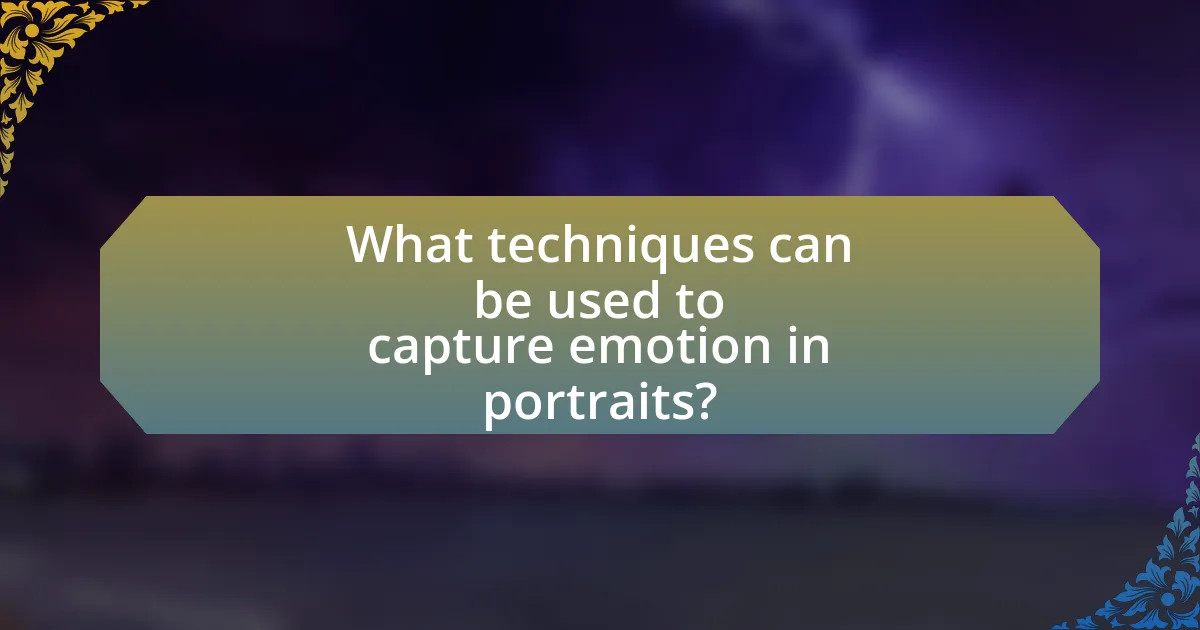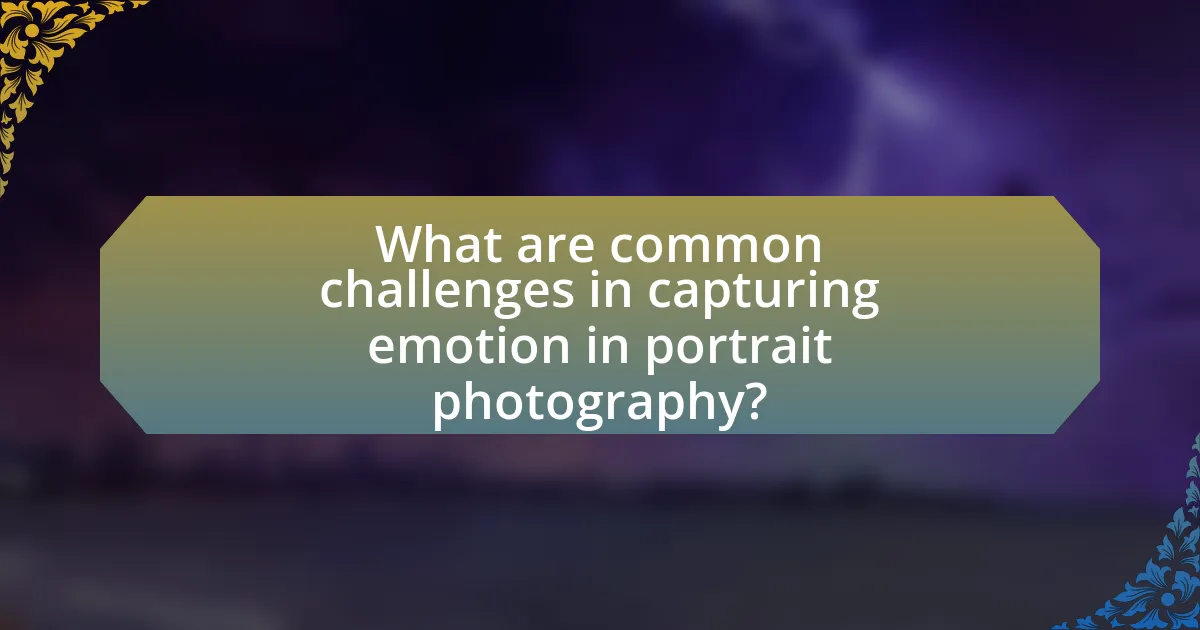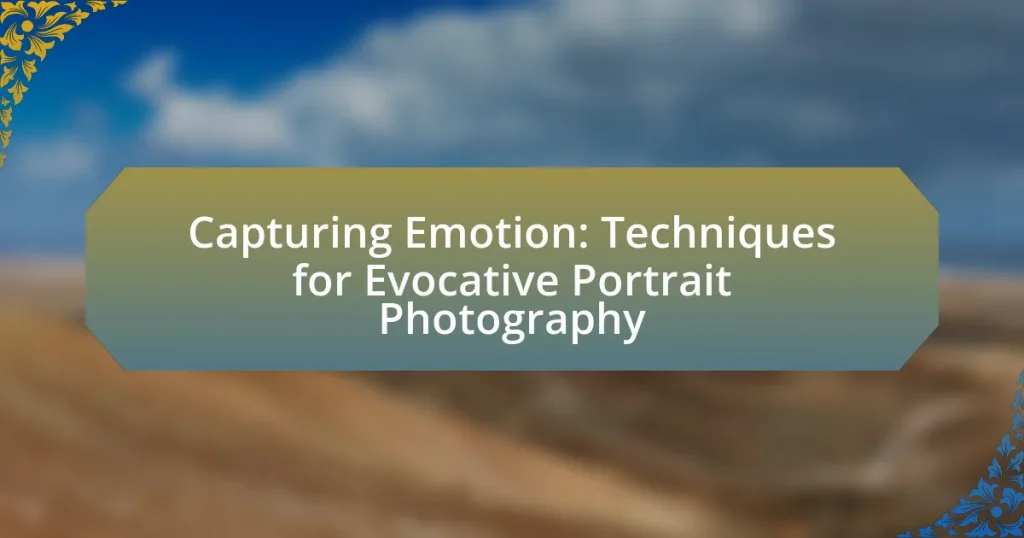Evocative portrait photography is a specialized style focused on capturing deep emotions and personal narratives through visual imagery. This article explores the significance of emotion in portrait photography, detailing key elements such as facial expressions, body language, lighting, and composition that contribute to emotional resonance. It also discusses techniques for capturing genuine emotions, the impact of subject interaction, and strategies for overcoming challenges like self-consciousness. Additionally, the article highlights best practices for post-processing to enhance emotional impact, including color grading and contrast adjustments, providing practical tips for photographers to improve their emotional portrait photography.

What is Evocative Portrait Photography?
Evocative portrait photography is a style that aims to capture and convey deep emotions and personal narratives through visual imagery. This approach often utilizes lighting, composition, and subject expression to create a powerful connection between the viewer and the subject, making the emotions palpable. Techniques such as close-up shots, dramatic lighting, and thoughtful poses are commonly employed to enhance the emotional impact of the portrait.
How does emotion play a role in portrait photography?
Emotion is central to portrait photography as it influences the viewer’s connection to the subject. Capturing genuine emotions can evoke empathy and resonance, making the portrait more impactful. Research indicates that portraits that convey strong emotions, such as joy or sadness, are more likely to engage viewers and elicit emotional responses, enhancing the overall effectiveness of the image. For instance, a study published in the journal “Emotion” by authors such as Paul Ekman highlights how facial expressions can communicate complex emotional states, reinforcing the importance of emotion in visual storytelling within portrait photography.
What are the key elements that convey emotion in portraits?
The key elements that convey emotion in portraits include facial expressions, body language, lighting, and composition. Facial expressions, such as smiles or frowns, directly communicate feelings and can evoke empathy in viewers. Body language, including posture and gestures, further enhances the emotional narrative by indicating confidence, vulnerability, or tension. Lighting plays a crucial role; soft, diffused light can create a warm, inviting atmosphere, while harsh shadows can evoke drama or sadness. Lastly, composition, including the use of negative space and framing, guides the viewer’s focus and can amplify the emotional impact of the subject. These elements work together to create a powerful emotional resonance in portrait photography.
How can lighting influence the emotional tone of a portrait?
Lighting significantly influences the emotional tone of a portrait by altering the mood and perception of the subject. For instance, soft, diffused lighting can evoke feelings of calmness and intimacy, while harsh, direct lighting may create a sense of drama or tension. Studies in photography demonstrate that the direction, intensity, and color of light can dramatically affect how viewers interpret emotions; for example, Rembrandt lighting, characterized by a triangle of light on the subject’s cheek, often conveys depth and complexity in emotional expression. Thus, the strategic use of lighting is essential in portrait photography to effectively communicate the desired emotional tone.
Why is capturing emotion important in portrait photography?
Capturing emotion is important in portrait photography because it creates a deeper connection between the subject and the viewer. Emotional expressions convey stories and experiences, allowing the audience to engage with the image on a personal level. Research indicates that photographs that evoke emotions are more likely to be remembered and shared, enhancing their impact. For instance, a study published in the journal “Emotion” found that images eliciting strong emotional responses are processed more deeply by viewers, leading to greater retention and resonance. Thus, capturing emotion transforms a simple portrait into a powerful narrative.
How does emotional connection enhance viewer engagement?
Emotional connection enhances viewer engagement by creating a sense of relatability and resonance with the content. When viewers feel an emotional bond, they are more likely to invest their attention and time, leading to deeper engagement. Research indicates that emotionally charged content can increase viewer retention by up to 65%, as emotions trigger the brain’s reward system, making the experience more memorable. This connection fosters empathy and encourages viewers to share their experiences, further amplifying engagement through social interaction.
What impact does emotion have on the storytelling aspect of portraits?
Emotion significantly enhances the storytelling aspect of portraits by conveying depth and context. When a portrait captures genuine emotion, it allows viewers to connect with the subject on a personal level, evoking empathy and understanding. Research indicates that portraits expressing strong emotions can lead to more profound viewer engagement, as demonstrated in studies where participants rated emotionally charged images as more memorable and impactful. This emotional resonance transforms a simple image into a narrative, inviting viewers to interpret the subject’s experiences and feelings, thereby enriching the overall storytelling experience.

What techniques can be used to capture emotion in portraits?
To capture emotion in portraits, photographers can utilize techniques such as effective lighting, composition, and the use of candid moments. Effective lighting, particularly soft and diffused light, can enhance the subject’s features and evoke a specific mood. Composition techniques, like the rule of thirds or leading lines, can draw attention to the subject’s expression, making the emotion more palpable. Additionally, capturing candid moments allows for genuine expressions, which often convey deeper emotional resonance. Research indicates that emotional expressions are more accurately perceived when they are spontaneous, as shown in studies on facial recognition and emotional intelligence.
How can composition affect the emotional impact of a portrait?
Composition significantly influences the emotional impact of a portrait by guiding the viewer’s focus and shaping the narrative conveyed through the image. Elements such as framing, balance, and the arrangement of subjects can evoke specific feelings; for instance, a tightly framed portrait can create intimacy, while a wider composition may evoke a sense of isolation. Research indicates that the rule of thirds, which suggests placing subjects off-center, can enhance visual interest and emotional engagement, as it encourages viewers to explore the entire image rather than fixating on a single point. Additionally, the use of negative space can amplify feelings of loneliness or contemplation, as seen in portraits where the subject is small in relation to their surroundings. Thus, effective composition not only enhances aesthetic appeal but also deepens the emotional resonance of a portrait.
What are the best practices for framing subjects to evoke emotion?
The best practices for framing subjects to evoke emotion include using close-ups, selecting appropriate backgrounds, and utilizing natural light. Close-ups create intimacy and allow viewers to connect with the subject’s emotions, as demonstrated in portrait photography where facial expressions are highlighted. Choosing backgrounds that complement the subject’s mood can enhance the emotional impact; for instance, a serene landscape can evoke calmness, while an urban setting may convey tension. Additionally, natural light can create soft shadows and highlights that add depth to the subject’s features, further enhancing emotional resonance. Studies in visual perception indicate that viewers are more likely to empathize with subjects framed in emotionally charged contexts, reinforcing the effectiveness of these techniques.
How does the use of negative space contribute to emotional expression?
The use of negative space significantly enhances emotional expression by creating a sense of isolation or focus on the subject. Negative space, which refers to the area surrounding the main subject, can evoke feelings of loneliness, contemplation, or tranquility, depending on its composition. For instance, a portrait with ample negative space around the subject can emphasize their emotional state, making the viewer more aware of the subject’s feelings. Studies in visual perception indicate that negative space can guide the viewer’s attention and influence their emotional response, reinforcing the intended mood of the photograph.
What role does subject interaction play in capturing emotion?
Subject interaction is crucial in capturing emotion as it fosters genuine connections between the photographer and the subject, leading to more authentic expressions. When subjects feel comfortable and engaged, they are more likely to display emotions that resonate with viewers. Research indicates that emotional expressions are significantly influenced by interpersonal dynamics; for instance, a study published in the Journal of Nonverbal Behavior highlights that positive interactions can enhance emotional authenticity in portraits. Thus, effective subject interaction not only facilitates emotional expression but also enriches the overall impact of the portrait.
How can photographers create a comfortable environment for subjects?
Photographers can create a comfortable environment for subjects by establishing clear communication and building rapport before the shoot. This approach helps subjects feel at ease, which is essential for capturing authentic emotions. Research indicates that positive interactions between photographers and subjects can significantly enhance the subject’s comfort level, leading to more natural expressions and poses. For instance, a study published in the Journal of Visual Communication in Medicine highlights that subjects who feel comfortable are more likely to engage positively with the camera, resulting in higher-quality images.
What techniques can be used to elicit genuine emotions from subjects?
To elicit genuine emotions from subjects, photographers can employ techniques such as establishing a connection, using open-ended questions, and creating a comfortable environment. Establishing a connection involves building rapport with the subject, which can lead to more authentic expressions. Open-ended questions encourage subjects to share personal stories or feelings, facilitating emotional responses. Creating a comfortable environment reduces anxiety, allowing subjects to relax and express themselves more freely. Research indicates that emotional authenticity in photography is enhanced when subjects feel understood and safe, as demonstrated in studies on interpersonal communication and emotional expression.

What are common challenges in capturing emotion in portrait photography?
Common challenges in capturing emotion in portrait photography include establishing a connection with the subject, managing lighting conditions, and overcoming the subject’s self-consciousness. Establishing a connection is crucial because it allows the photographer to evoke genuine emotions, which can be hindered by a lack of trust or rapport. Lighting conditions can significantly affect the mood of the portrait; harsh or unflattering light can obscure emotional nuances. Additionally, subjects often feel self-conscious in front of the camera, which can lead to stiff or unnatural expressions, making it difficult to capture authentic emotion. These challenges require photographers to employ effective communication, technical skills, and a comfortable environment to facilitate genuine emotional expression.
How can photographers overcome barriers to emotional expression?
Photographers can overcome barriers to emotional expression by fostering a genuine connection with their subjects. Establishing trust and rapport allows subjects to feel comfortable, which can lead to more authentic emotional displays. Techniques such as active listening, engaging in meaningful conversation, and creating a relaxed environment contribute to this connection. Research indicates that emotional expression in photography is significantly enhanced when subjects feel understood and valued, as demonstrated in studies on interpersonal communication and emotional intelligence.
What strategies can be employed to build rapport with subjects?
To build rapport with subjects, photographers can employ strategies such as active listening, establishing a comfortable environment, and using open body language. Active listening involves fully engaging with the subject’s thoughts and feelings, which fosters trust and connection. Creating a comfortable environment, such as choosing a familiar location or allowing subjects to express their preferences, helps subjects feel at ease. Open body language, including maintaining eye contact and using inviting gestures, signals approachability and encourages subjects to relax. Research indicates that these strategies enhance interpersonal communication, leading to more authentic and emotive portrait outcomes.
How can photographers handle subjects who are camera-shy or reserved?
Photographers can handle camera-shy or reserved subjects by creating a comfortable environment and using techniques that encourage natural interaction. Establishing rapport through conversation before the shoot helps build trust, making subjects feel more at ease. Additionally, employing candid photography techniques allows subjects to relax and engage in activities rather than posing directly for the camera, which can reduce anxiety. Research indicates that subjects are more likely to exhibit genuine emotions when they feel comfortable, as shown in studies on social interactions and photography.
What are the best practices for post-processing to enhance emotional impact?
The best practices for post-processing to enhance emotional impact include adjusting contrast, color grading, and utilizing selective focus. Adjusting contrast can emphasize the subject’s features and create a more dramatic effect, which can evoke stronger emotions. Color grading allows for the manipulation of hues and tones to match the mood of the photograph; for instance, warmer tones can convey comfort and intimacy, while cooler tones may evoke sadness or isolation. Selective focus draws attention to the subject by blurring the background, enhancing the emotional connection between the viewer and the subject. These techniques are supported by studies in visual perception, which indicate that contrast and color significantly influence emotional responses in viewers.
How can color grading influence the mood of a portrait?
Color grading can significantly influence the mood of a portrait by altering the emotional perception conveyed through color tones. For instance, warm tones like reds and oranges can evoke feelings of warmth, happiness, or intimacy, while cool tones such as blues and greens may create a sense of calmness, sadness, or detachment. Research in color psychology supports this, indicating that colors can elicit specific emotional responses; for example, a study published in the journal “Color Research and Application” found that warm colors are often associated with positive emotions, while cool colors are linked to negative emotions. Thus, the choice of color grading directly impacts how viewers emotionally connect with the portrait.
What editing techniques can help emphasize emotional expressions?
Editing techniques that can help emphasize emotional expressions include color grading, contrast adjustment, cropping, and the use of vignette effects. Color grading can enhance the mood by altering hues and saturation, making emotions more vivid; for instance, warmer tones can evoke feelings of happiness or warmth, while cooler tones can convey sadness or detachment. Contrast adjustment sharpens the distinction between light and dark areas, drawing attention to facial features that express emotion. Cropping can focus the viewer’s attention on the subject’s face, eliminating distractions and highlighting emotional nuances. Additionally, applying vignette effects can subtly guide the viewer’s gaze toward the subject, enhancing the emotional impact of the portrait. These techniques are widely used in portrait photography to create a more evocative and emotionally resonant image.
What practical tips can photographers follow to improve their emotional portrait photography?
Photographers can improve their emotional portrait photography by establishing a genuine connection with their subjects. Building rapport encourages subjects to express their emotions more freely, resulting in more authentic portraits. Techniques such as engaging in conversation, using open body language, and creating a comfortable environment can facilitate this connection. Research indicates that emotional expression in photography is significantly enhanced when subjects feel at ease, as noted in a study published in the Journal of Visual Communication in Medicine, which found that relaxed subjects exhibit more natural emotional responses. Additionally, utilizing natural light can enhance the mood of the portrait, as it creates softer shadows and highlights that evoke emotion.















